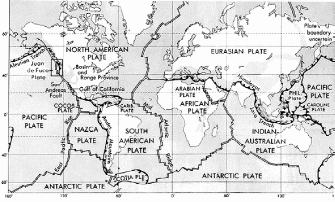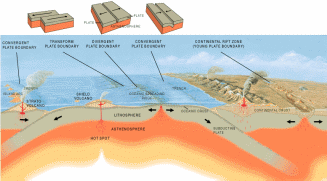Abstract
This paper aims to show the relationship between the Plate Tectonics and Continental Drift theories which made advances in the field of geology.
Overview
Plate tectonics is a hypothetical movement of earth’s crust plates: a theory that ascribes continental drift, volcanic and seismic activity, and the formation of mountain belts to moving plates of the Earth’s crust supported on less rigid mantle rocks.
Plate Tectonics theory, formulated during the early 1960s, explains that earth’s crust comprise thin, rigid plates that depend its movement with each other; plate tectonics transfigured the study of the earth. It helped scientists to explain several geological events, such as earthquakes and volcanic eruptions as well as mountain building and the formation of the oceans and continents.
In 1912, German scientist Alfred Wegener examined the shapes of the continents and found that they fit together like a jigsaw puzzle. Using this observation, along with geological evidence he found on different continents, he developed the theory of continental drift, which states that today’s continents were once joined together into one large landmass, called Pangaea that split, and drifted apart into seven continents that we have today and in places collided again. This theory describes and illustrates the formation, alteration, and the exact movement of the continents across the Earth’s crust.
The first comprehensive theory of continental drift was suggested by the German meteorologist Alfred Wegener in 1912. The hypothesis asserts that the continents consist of lighter rocks that rest on heavier crustal material—similar to the manner in which icebergs float on water. Wegener contended that the relative positions of the continents are not rigidly fixed but are slowly moving—at a rate of about one yard per century.
According to the generally accepted plate-tectonics theory, scientists believe that Earth’s surface is broken into a number of shifting slabs or plates, which average about 50 miles in thickness. These plates move relative to one another above a hotter, deeper, more mobile zone at average rates as great as a few inches per year. Most of the world’s active volcanoes are located along or near the boundaries between shifting plates and are called plate-boundary volcanoes.
The peripheral areas of the Pacific Ocean Basin, containing the boundaries of several plates, are dotted with many active volcanoes that form the so-called Ring of Fire. The Ring provides excellent examples of plate-boundary volcanoes, including Mount St. Helens. However, some active volcanoes are not associated with plate boundaries, and many of these so-called intra-plate volcanoes form roughly linear chains in the interior of some oceanic plates. The Hawaiian Islands provide perhaps the best example of an intra-plate volcanic chain, developed by the northwest-moving Pacific plate passing over an inferred “hot spot” that initiates the magma-generation and volcano-formation process.
Between 1950s and 1960s, geologists found evidence behind the idea of tectonic plates and their movement. They used Wegener’s claim in various aspects of earth’s changes and used this evidence to confirm continental drift. In 1968, scientists incorporated most geologic activities into a theory called the New Global Tectonics commonly known as Plate Tectonics.
Plate tectonics theory – the Lithosphere Plates of Earth
According to U.S. Department of Interior, Geological Survey, this figure shows the boundaries of lithosphere plates that are active at present. The double lines indicate zones of spreading from which plates are moving apart. The lines with barbs show zones of under thrusting (subduction), where one plate is sliding beneath another. The barbs on the lines indicate the overriding plate. The single line defines a strike-slip fault along which plates are sliding horizontally past one another. The stippled areas indicate a part of a continent, exclusive of that along a plate boundary, which is undergoing active extensional, compressional, or strike-slip faulting.
Conclusion
Plate tectonics and continental drift theories formulated by Wegener that were later confirmed by evidences and findings of later scientists opened avenues in the advancement of geology, explaining the details of earth’s movements, and the occurrence of drifts, faults, plates and ridges in the earth’s crust caused by different forces.
However, biblically speaking, it is said that, “…all the fountains of the great deep came bursting through, and the windows of heaven were open;” it caused great earthquake which is the possible result of the drifting apart of the continents (KJVA, Gen 7.11).

Wegener relied on geological evidence and fossil records to support his theory that the landmass slowly separated through continental drift. In the 1960s researchers confirmed Wegener’s theory when they observed seafloor spreading and other phenomena. This research eventually led to the theory and study of plate tectonics.


References
“Continental Drift and Plate-Tectonics Theory.” Web.
Coney, Peter. “Plate Tectonics.” Microsoft® Encarta® 2007 [DVD]. Redmond, WA: Microsoft Corporation, 2006.
“Geology: Plate Tectonics.” Web.
Crystal, Ellie. “Continental Drift and Plates Tectonics.” Web.
The Holy Bible, English Standard Version, copyright © 2001 by Crossway Bibles, a division of Good News Publishers.
1769 King James Version of the Holy Bible.